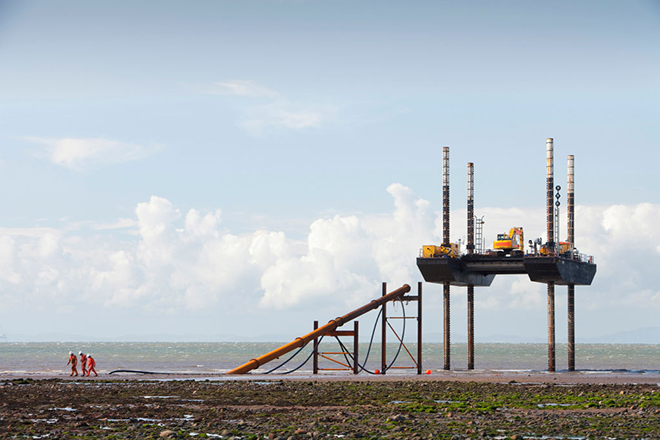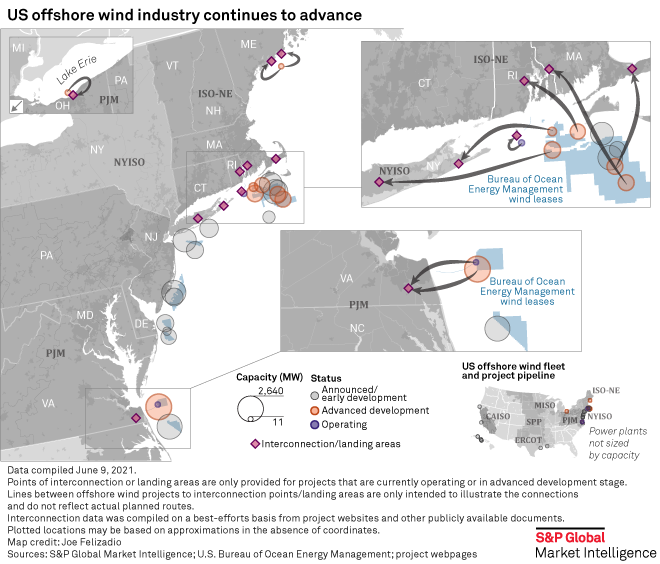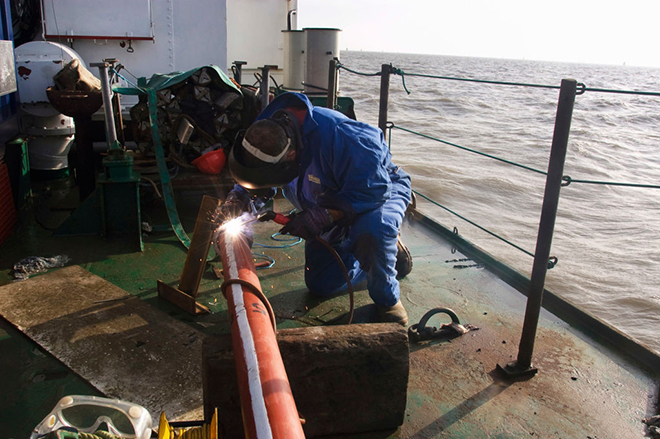S&P Global Offerings
Featured Topics
Featured Products
Events
S&P Global Offerings
Featured Topics
Featured Products
Events
S&P Global Offerings
Featured Topics
Featured Products
Events
Banking & Capital Markets
Economy & Finance
Energy Transition & Sustainability
Technology & Innovation
Podcasts & Newsletters
Banking & Capital Markets
Economy & Finance
Energy Transition & Sustainability
Technology & Innovation
Podcasts & Newsletters
S&P Global Offerings
Featured Topics
Featured Products
Events
6 Jul, 2021
By Justin Horwath and Yannic Rack

| A jack-up barge installing the power cable for the Robin Rigg offshore wind farm in the U.K. Developers in Europe have been building offshore transmission infrastructure for more than a decade. |
As the Biden administration pushes ahead with offshore wind development in the U.S., the burgeoning industry is confronting an issue of growing importance: how to build the huge amount of electric cabling needed to deliver all that power from sea to the onshore grid.
The U.S. wants to install 30 GW of offshore wind parks by the end of the decade, more than all of Europe has built to date. But some in the industry are sounding alarms that it may fall short of that target if federal agencies, states and grid operators do not coordinate on transmission plans.
That is partly because offshore wind developers in the U.S. committed to the so-called generator lead line approach where they build individual transmission lines themselves, linking up wind farms one by one to the onshore high-voltage network. That approach is driven by state solicitations that bundle generation and transmission.
But interconnection points near coasts are limited, and some U.S. policymakers are now looking to Europe where mounting local opposition against cable landing points and the renewables-driven need for more interconnections between national grids sparked debate about a more integrated approach to building transmission at sea. In New Jersey, regulators are considering whether a planned transmission network for offshore wind farms, built by independent developers, would make more sense than the go-it-alone approach favored by generators.
Brandon Burke, vice president of policy and regulatory engagement for the Business Network for Offshore Wind, which advocates a more coordinated transmission strategy, said the issue is not unique to offshore wind.
"This is a challenge with transmission planning in the U.S. generally," Burke said in an interview. "It tends not to holistically account for the benefits that may occur, so the projects are siloed into these discrete categories that may not reflect their physical reality to enhancements to the system."
Experts say states would do well to heed the lessons learned in Europe, warning that the current U.S. approach of building individual transmission lines could be short-sighted as offshore development continues to accelerate.
"It'll be easy to start with, but then it will suddenly become a lot harder," Andy Strowbridge, an associate director at U.K.-based consultancy BVG Associates, said in an interview.
Interconnection queues 'exploding'
The long list of projects that applied for grid access offers a sign of what's to come for grid operators — not only in New England but also in emerging markets like the Gulf of Mexico and California.
More than 52 GW of proposed offshore wind interconnections were in the queues for the PJM Interconnection, New York ISO and ISO New England as of October 2020, according to the Business Network for Offshore Wind. That number will only increase; in June, officials proposed a competitive lease sale in an area between Long Island, N.Y., and New Jersey known as the New York Bight, which alone could add more than 7 GW of capacity.
"Our interconnection queue is exploding," Ken Seiler, PJM's vice president of planning, said at an industry conference in May, noting that the grid operator is expecting more than 14 GW of offshore wind injections into its system over the next decade. There are now 18 GW of offshore wind interconnection requests in PJM's queue, a spokesperson said.

Looming pressure on the network means a more integrated approach to offshore transmission will be needed, according to independent network developers, experts and some former regulators.
Anbaric Development Partners LLC, a merchant transmission developer, has been at the forefront of pushing for a planned transmission system that connects multiple wind farms, arguing that it would cut costs by up to 30%, reduce environmental impacts, require fewer onshore grid upgrades and lower curtailments of offshore wind generation.
Anbaric filed interconnection requests with PJM, but the grid operator has denied them, saying that Anbaric needed to partner with a generator. The Federal Energy Regulatory Commission then denied a complaint Anbaric lodged against PJM, and in October 2020 convened a technical conference on how to handle offshore wind transmission. (Docket No. AD20-18)
"FERC needs to provide strong guidance here: Tell the RTOs, 'You need to be planning for this,'" Theodore Paradise, a partner and executive vice president of transmission strategy and counsel for Anbaric, said in an interview. "The planned grid is a great way to de-risk and go faster on transmission."
Jon Wellinghoff, CEO of consulting firm GridPolicy and FERC chairman from 2009 to 2013, argued in a statement to the commission that a so-called mesh network model proposed in a study by economists at The Brattle Group "is clearly superior" to the generator lead line approach. A mesh network, one of several potential planned approaches, would essentially see all offshore wind farms linked up with each other.
Grid operators need to create an offshore grid planning task force, Wellinghoff said in an interview. Absent any planned policy, "you're not going to have enough interconnection points to make [the 30-GW] goal."
FERC announced the creation of a joint task force with state regulators June 17 to address obstacles to building transmission. PJM in a statement said it is working with states to study regional offshore wind build-outs, and ISO New England said it is also collaborating with its states on future transmission needs.
New Jersey charts a path
New Jersey, which has an offshore wind capacity target of 7.5 GW by 2035, is now leading the way in forming a "transmission-first approach" for an open-access network. It is the first state in PJM's territory to take advantage of the state agreement approach, which allows the grid operator to solicit transmission proposals on behalf of a state and opens the door to collaboration between states.
In April, PJM opened a competitive solicitation for proposals to upgrade onshore transmission facilities and build new offshore transmission infrastructure. It is up to New Jersey regulators to accept or reject them. Proposals are due Aug. 13.
"Our approach is really one where we have as few transmission lines as possible coming in onshore," Joseph Fiordaliso, president of the New Jersey Board of Public Utilities, said in an interview. "We don't want 15 different transmission lines coming through."
New Jersey is looking to work with New York, but the New Jersey board wrote in a filing to FERC that such collaborations are hampered by questions around cost allocation — i.e., how to prevent free-riders from connecting to the grid without paying their fair share.
"New Jersey cannot be expected to carry this burden alone," the board said in the filing.
One study prepared for New Jersey regulators said a model in which an ocean grid developer builds the system and recovers its costs from project developers is "not viable because developers cannot obtain firm commitments from states or [offshore wind] developers, making financing virtually impossible."
Individual export cables place the majority of project risks on developers, whereas an ocean grid would ease interconnections but would likely be more expensive and take longer to construct, the study said. It suggested that regulators explore a power corridor in which multiple offshore wind projects deliver to a single point of interconnection through multiple cables.
"What's good for an individual wind farm isn't necessarily good for the industry in the U.S.," Anbaric's Paradise said of the go-it-alone approach.
Developers cling to control
For now, developers are taking on both wind farms and their grid connections, which they say streamlines development at a time when U.S. climate targets require a rapid scale-up of renewable energy.
They cite the importance of both securing a route to market for their power plants and being in charge of crucial issues that have the potential to delay projects for years, like where their cables make landfall.
"Our primary concern is timing; we can't wait for the perfect transmission system to be conceived of, permitted and built," Eric Wilkinson, an energy policy analyst for government affairs and regulatory policy for Danish offshore wind developer Ørsted A/S, said during an American Council on Renewable Energy conference in May.
Ørsted, the world's largest offshore wind developer, installed two pilot projects in the U.S. and has been awarded over 2.9 GW of capacity through five projects, including joint ventures with U.S. utilities Eversource Energy and Public Service Enterprise Group Inc. The company's COO, Martin Neubert, told S&P Global Market Intelligence at the company's capital markets day in June that Ørsted is "clearly in favor" of keeping transmission in the hands of the developer.
"That is a key lesson from Europe," Neubert said, pointing specifically to the experience in Germany where handing off control over transmission links to grid monopolies led to higher development costs compared with more competitive regimes, like in the U.K.
In some countries, including Germany and the Netherlands, national transmission operators proactively plan the rollout of the network and build lines out to sea. The U.K. developed its own approach, which sees generators build transmission lines to connect their wind farms but then sell the grid assets to independent operators who bid for them in auctions.
Offshore wind developers also emphasize that they have experience building the transmission lines. They are responsible for doing so in the U.K., the sector's biggest market, and are replicating that approach in emerging markets like Taiwan, where Ørsted is active.
"It's something we know very well," Neubert said.

| A welder onboard the barge 'The Wind,' laying cables for the Kentish Flats wind farm in the U.K. |
Lessons from Europe
Other developers are more open to the idea of eventually handing off control.
"[As] the first wave of projects are happening, the simplicity of the generator lead line makes a lot of sense," Eric Thumma, senior director of business development for offshore wind at Avangrid Inc., said. Avangrid is building the 800-MW Vineyard Offshore Wind Project with Copenhagen Infrastructure Partners K/S, the first large-scale offshore wind farm in the U.S. "It reduces complexity, and that is essential for these projects."
But as the industry matures and "it gets more complicated, we need to maybe look at some other solutions," Thumma said in an interview.
The British government, which wants to reach 40 GW of offshore wind by 2030, launched a study of a more coordinated approach for building both offshore wind transmission and subsea cables to other countries. A report by Britain's transmission grid operator found that the adoption of an integrated approach could save consumers 18%, or $8 billion, in capital and operating expenditures by 2050.
Meanwhile, National Grid PLC and Dutch transmission system operator TenneT Holding BV are already studying the feasibility of a multipurpose interconnector that would link future offshore wind farms in the waters off of both the U.K. and the Netherlands and provide up to 2 GW of power trading capacity. Grid companies see the potential to expand that model to other countries; in Denmark, the government also wants to build energy islands that connect multiple wind farms in a hub-and-spoke model.
With more mature offshore wind markets potentially moving to a centrally planned approach, industry observers suggest the U.S. could run into the same issues as its offshore build-out gathers pace.
"There are lessons they could learn," Chris Veal, managing director at London-headquartered Transmission Investment, said. The company, through its joint venture Transmission Capital Partners, won licenses to run seven offshore transmission links in the U.K.
"I think it's shifting, both in Britain and in the U.S., more towards a model where a transmission company would build as well as own and operate the transmission," Veal said. "When you move towards [that model], it becomes less obvious that the wind farm generators would be the builders of that."
